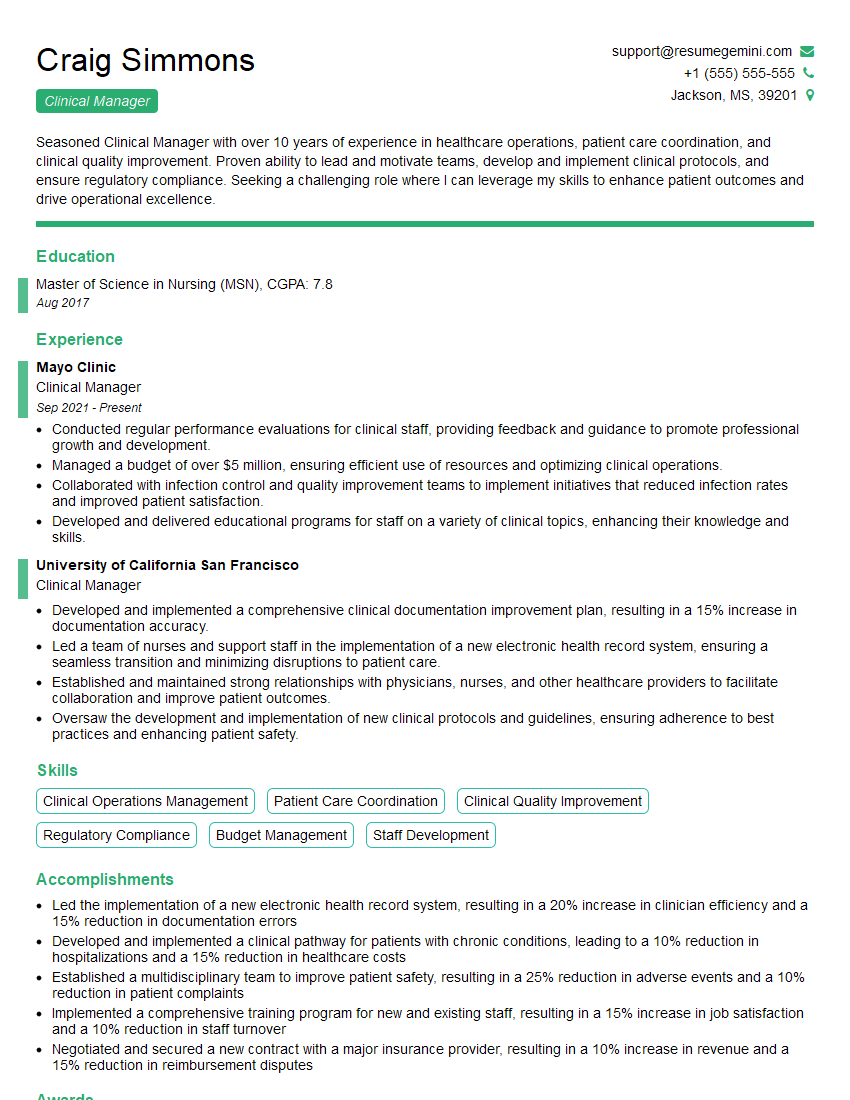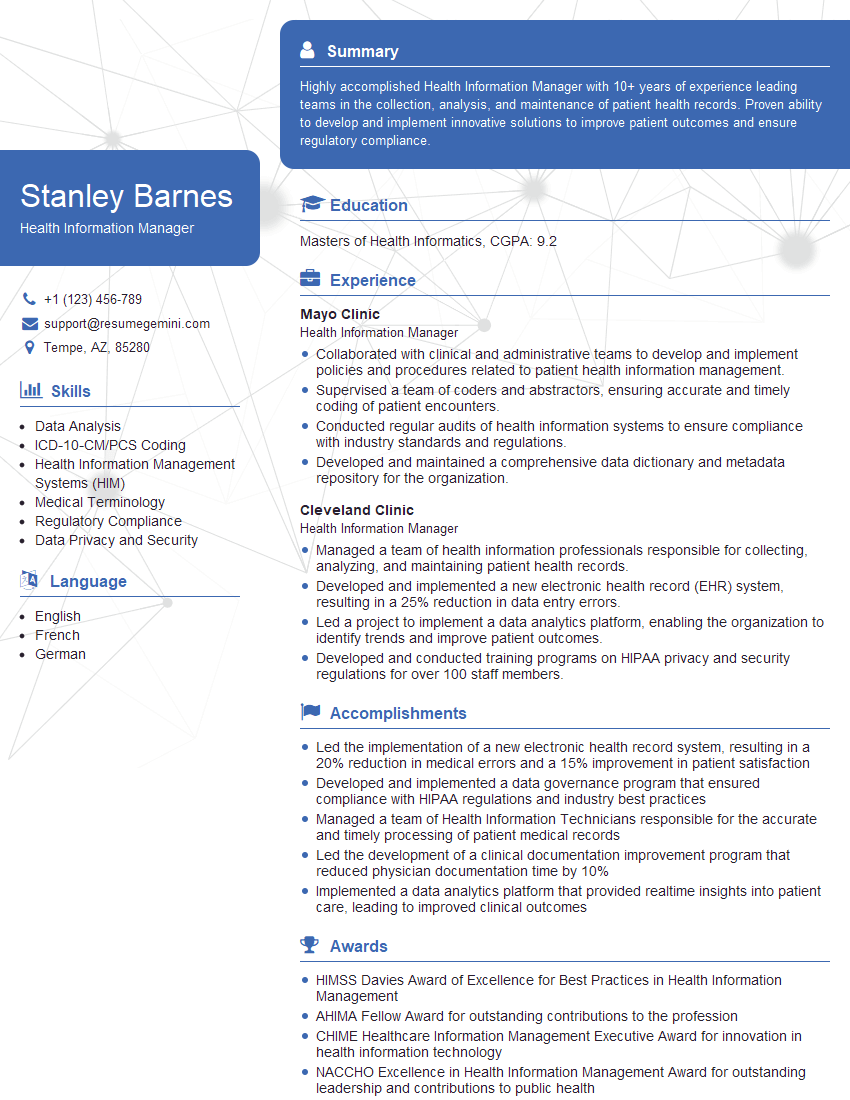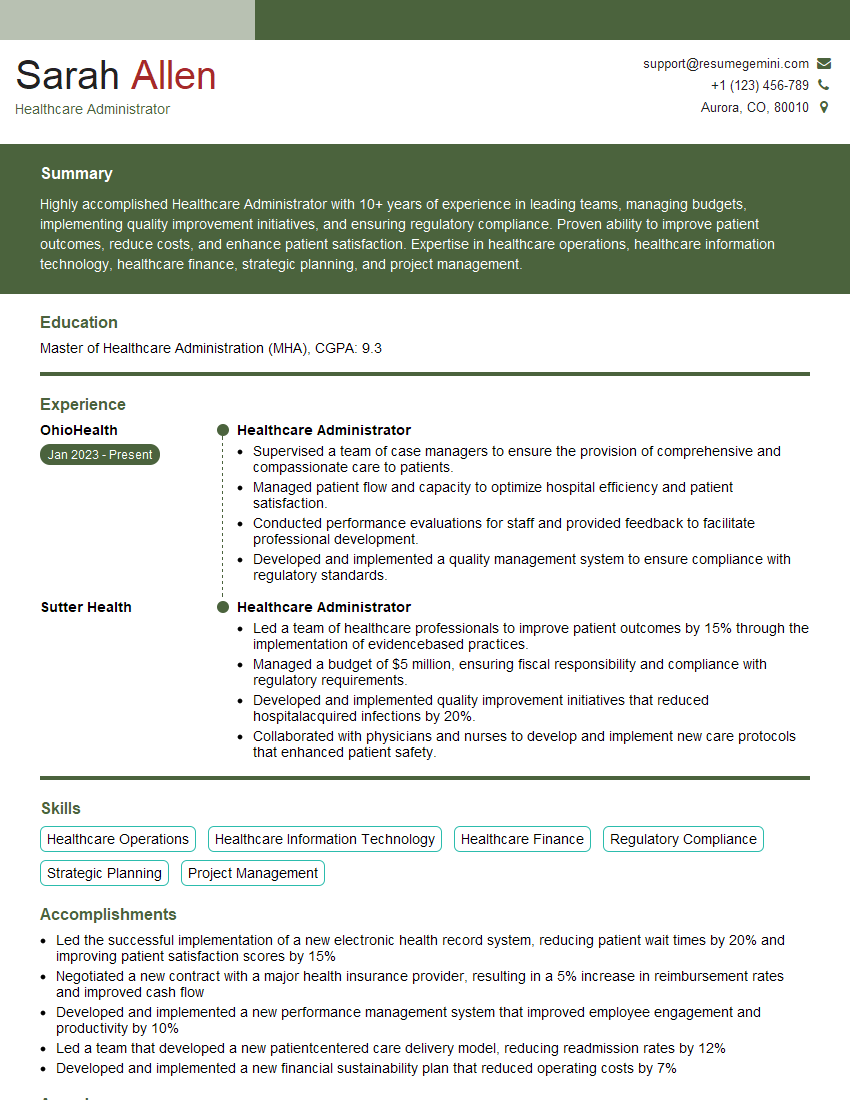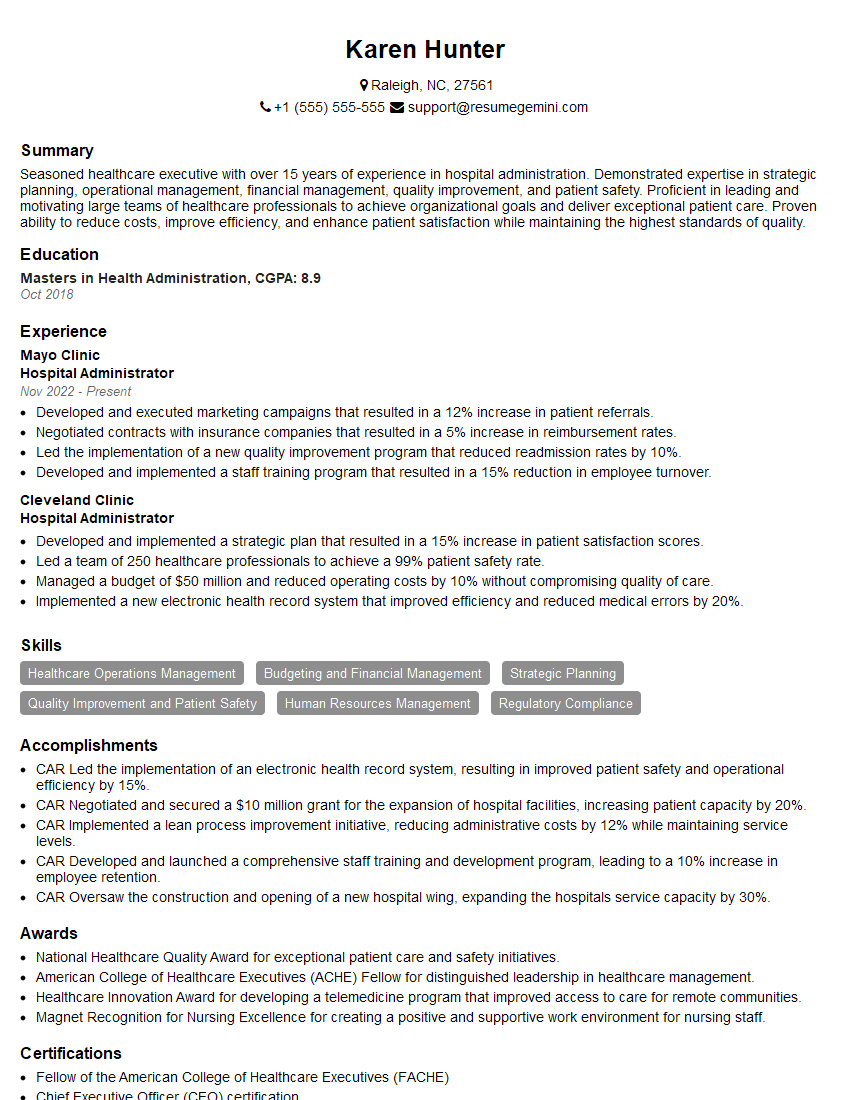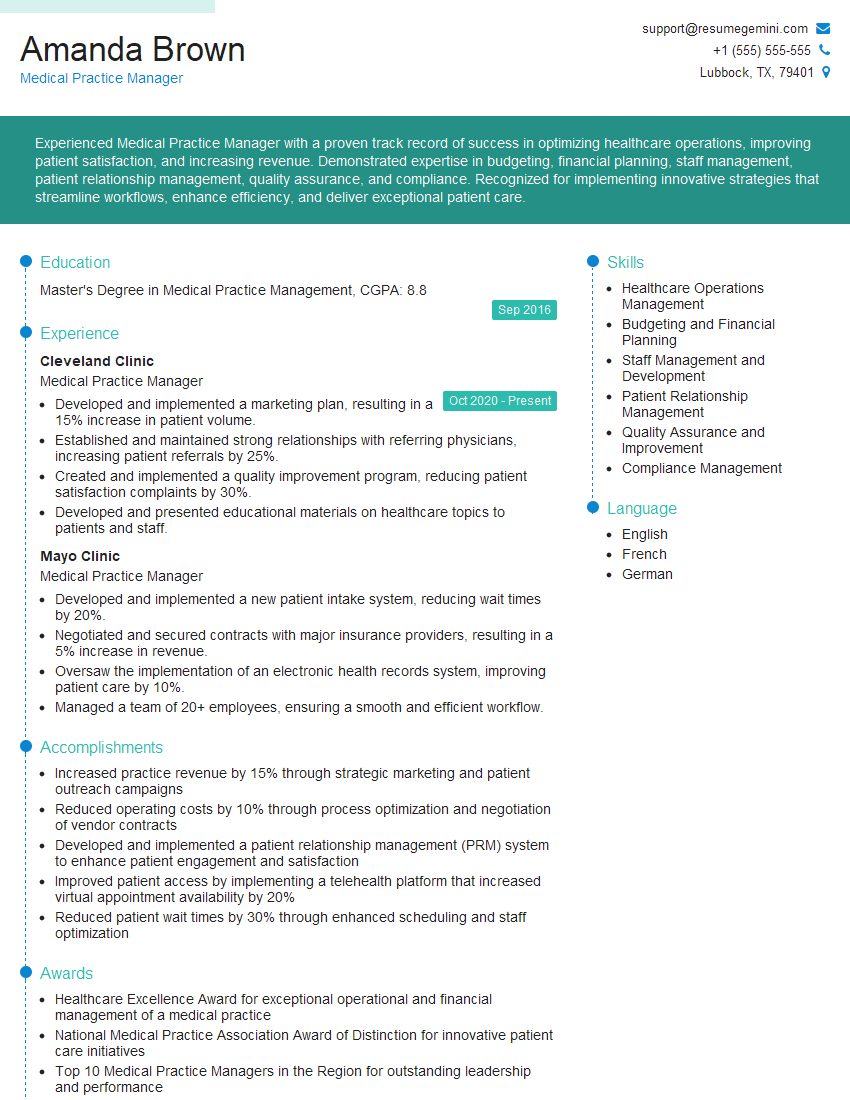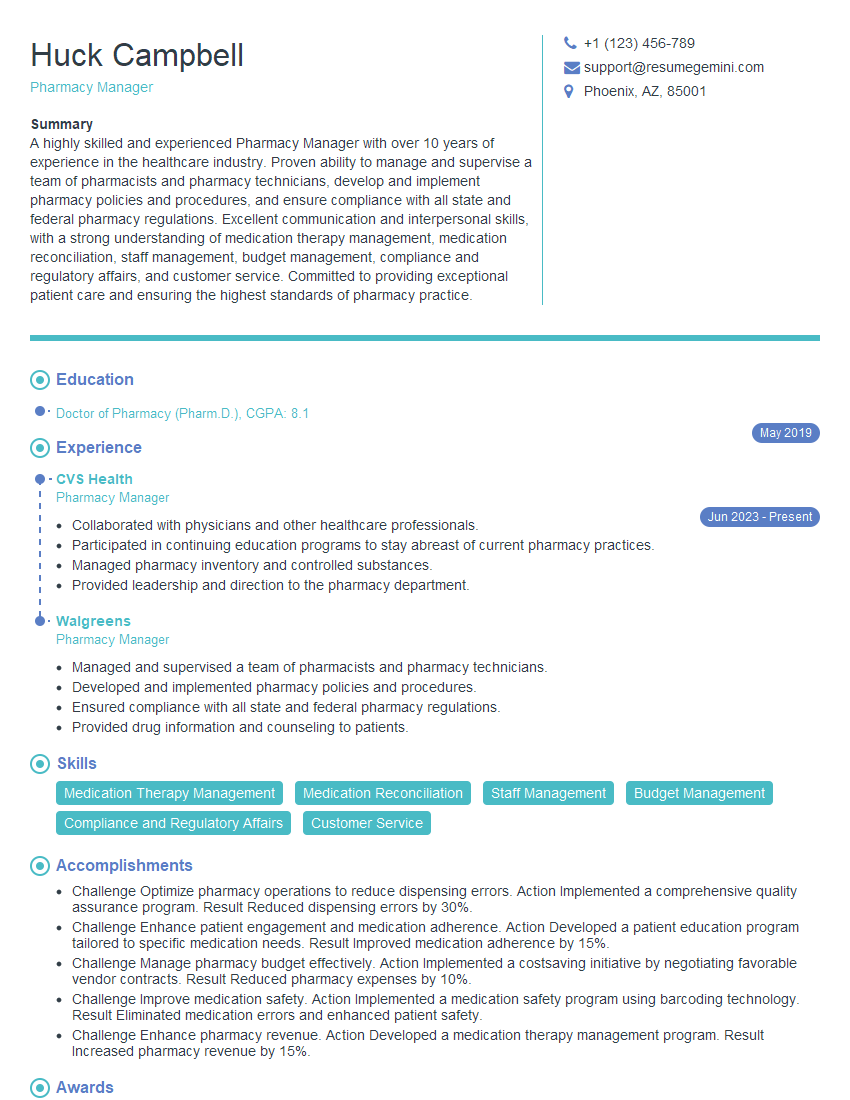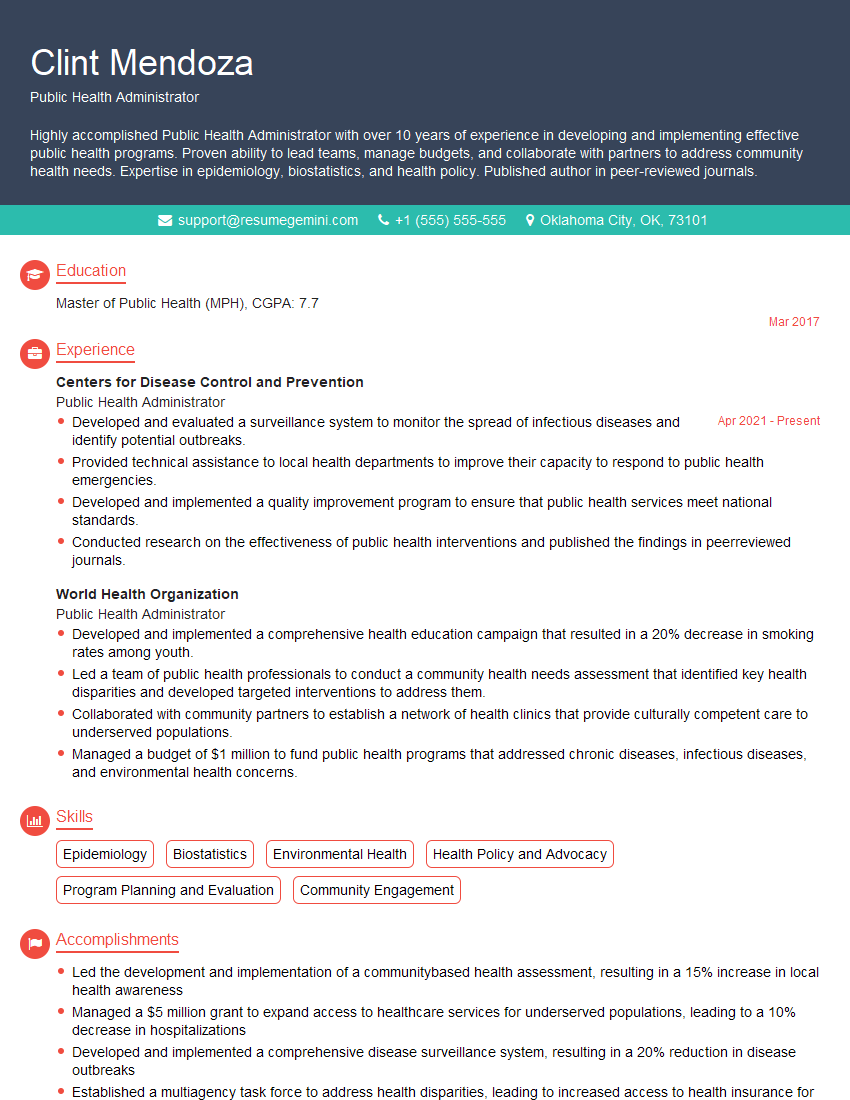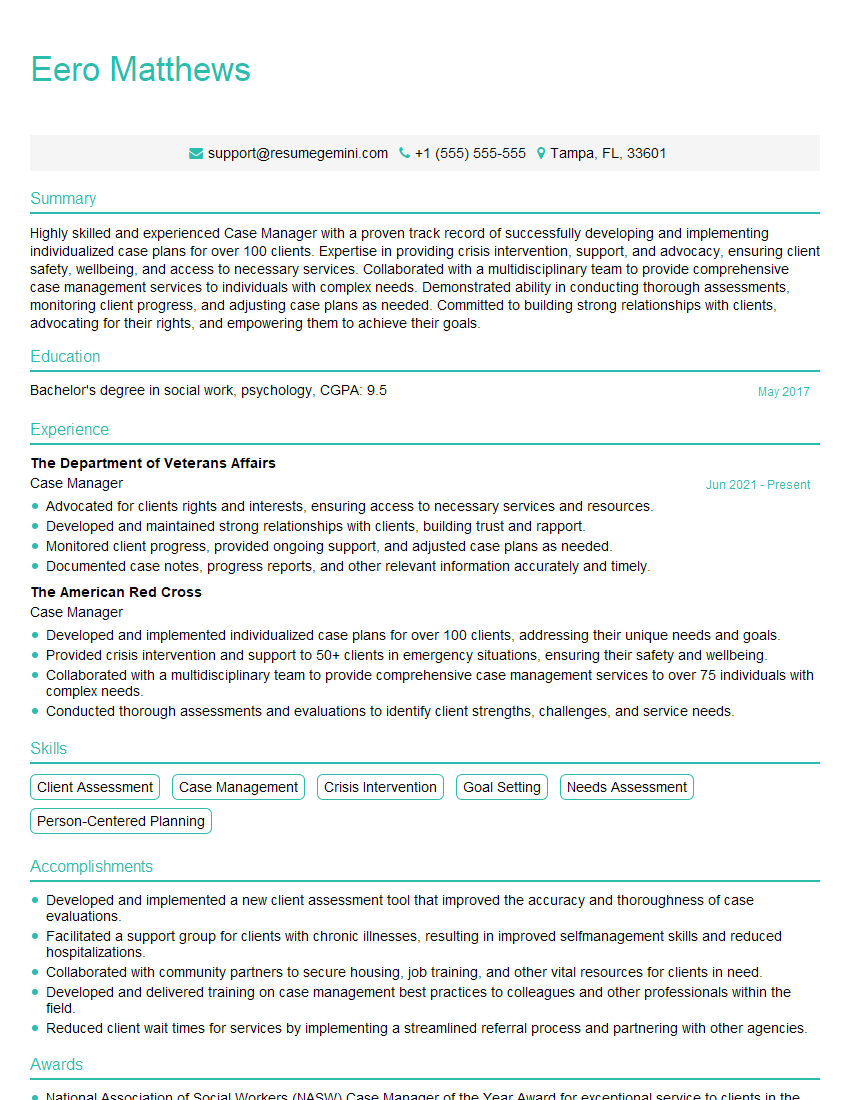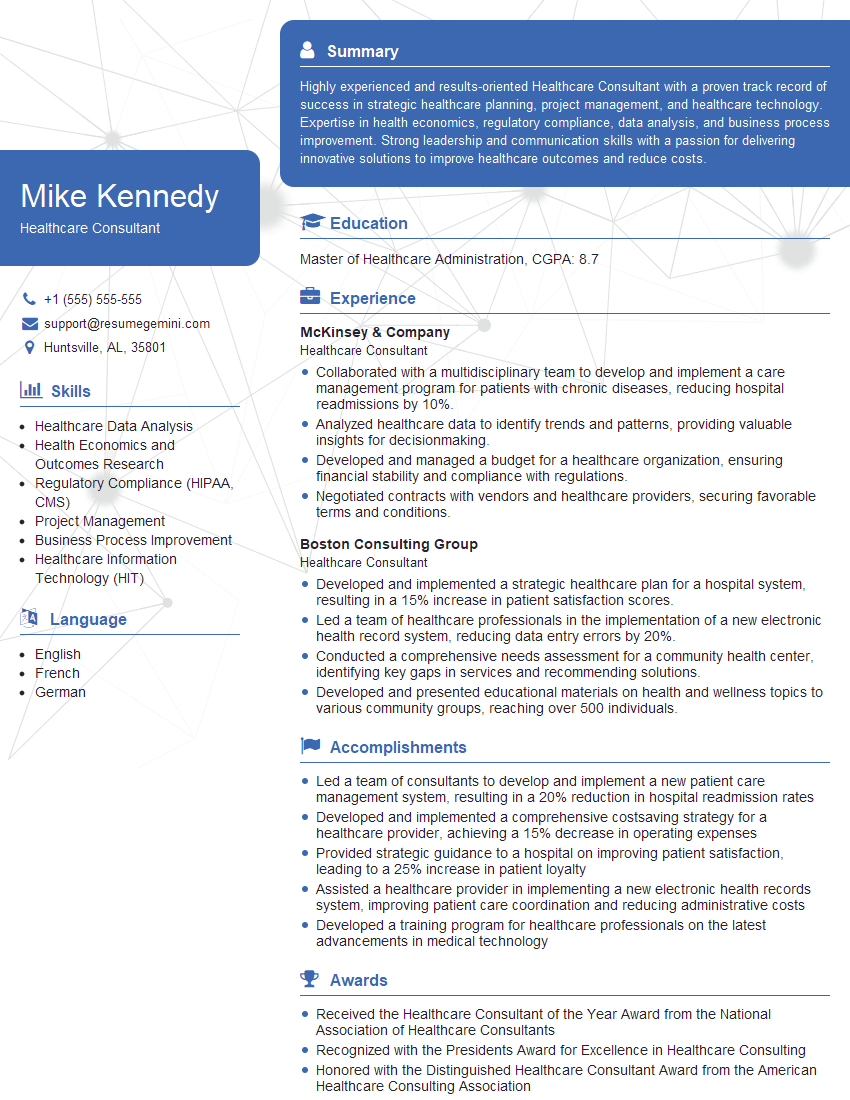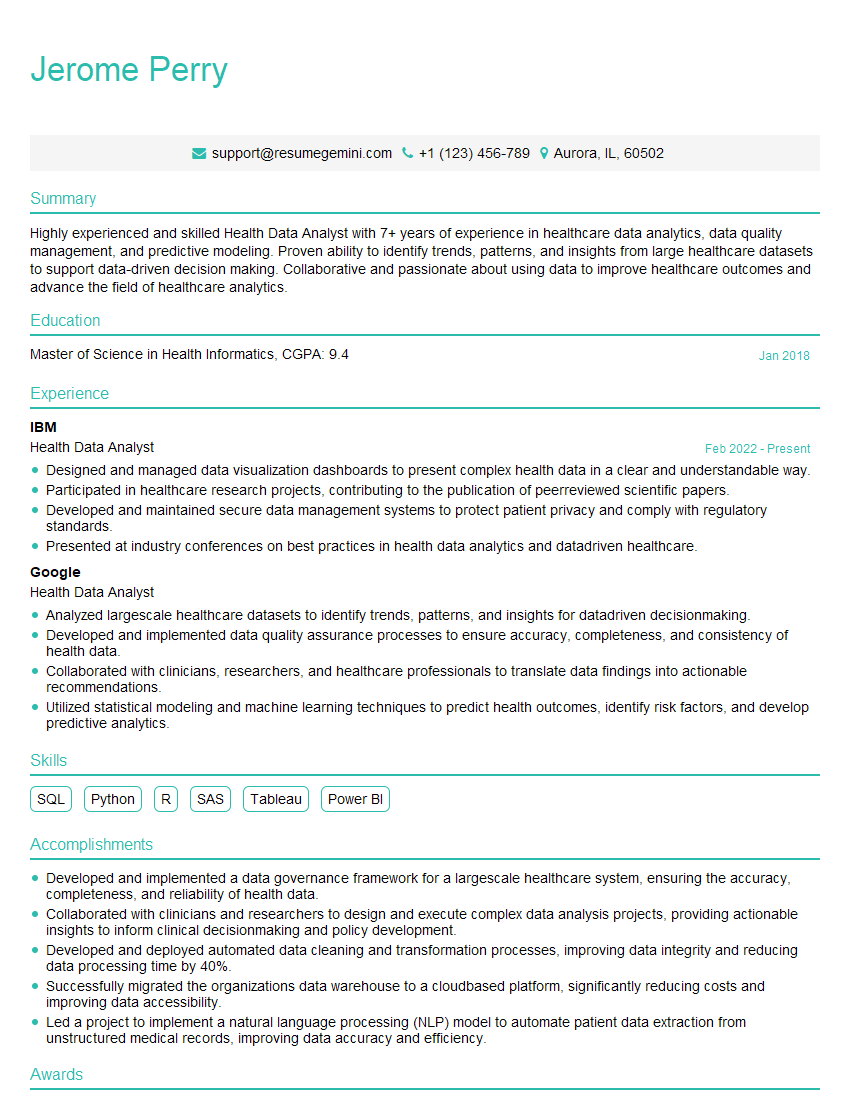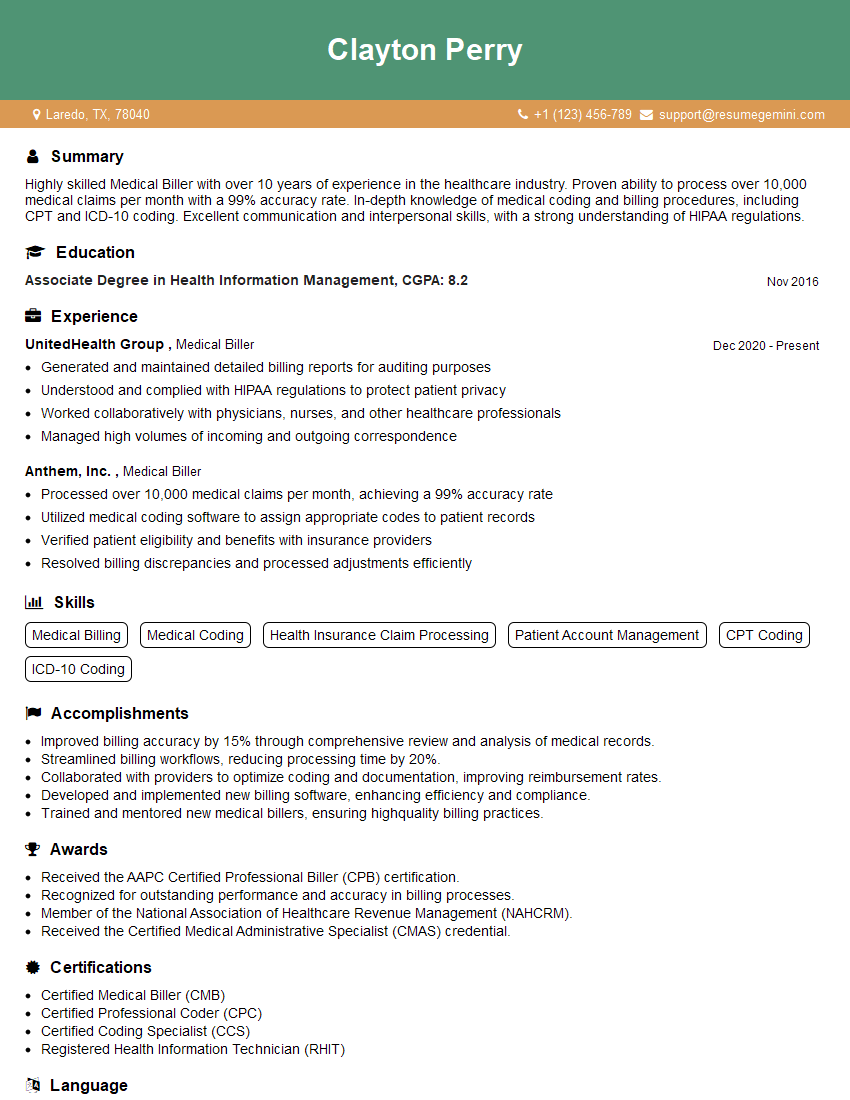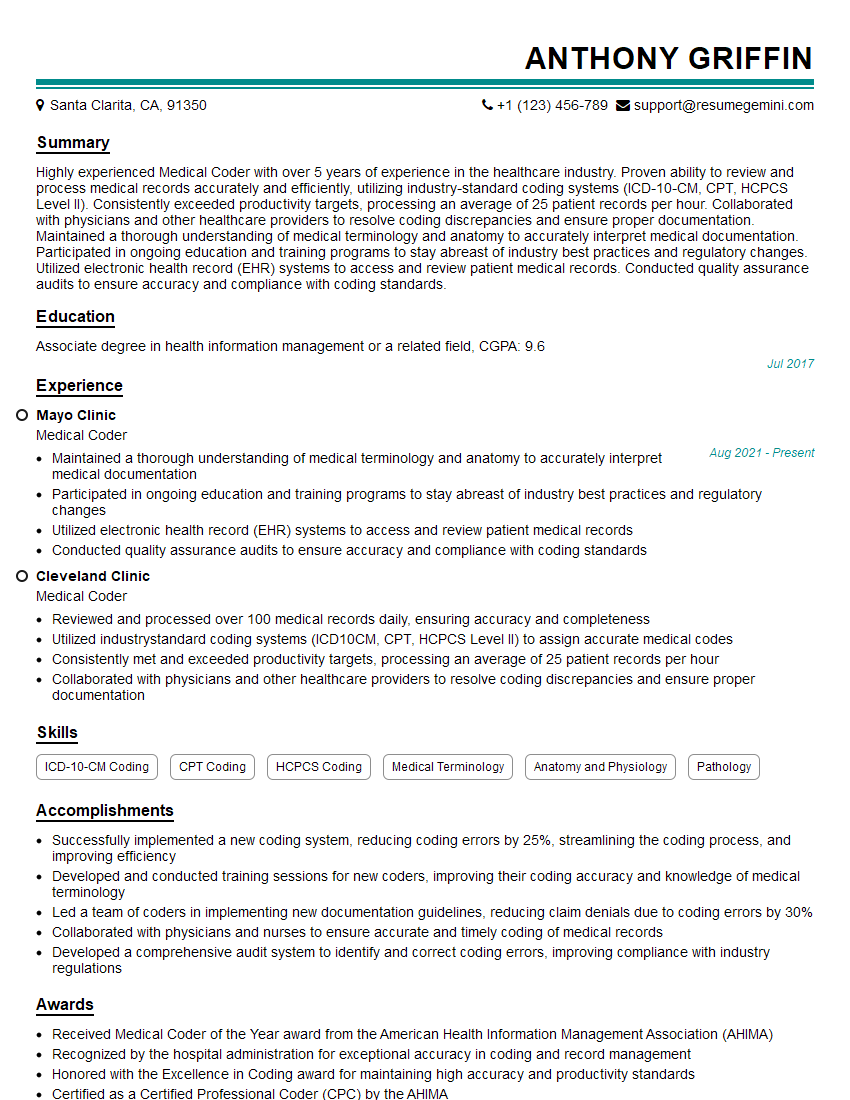Preparation is the key to success in any interview. In this post, we’ll explore crucial Health Management interview questions and equip you with strategies to craft impactful answers. Whether you’re a beginner or a pro, these tips will elevate your preparation.
Questions Asked in Health Management Interview
Q 1. Explain the differences between managed care and fee-for-service healthcare models.
Managed care and fee-for-service are two fundamentally different healthcare payment models. Fee-for-service (FFS) is a traditional system where providers bill for each service rendered. Think of it like buying groceries – you pay for each item individually. This can lead to a higher volume of services, not necessarily better care, as providers are incentivized to perform more procedures. In contrast, managed care emphasizes preventative care and coordinated services, aiming for better overall health outcomes at a potentially lower cost. It often involves health maintenance organizations (HMOs) or preferred provider organizations (PPOs) where patients choose from a network of providers and pay a premium for access. Imagine it like a health club membership – you pay a set fee for access to various services, with some services costing extra.
Key Differences:
- Payment Structure: FFS pays per service; Managed care involves pre-negotiated rates or capitation (payment per patient per period).
- Provider Choice: FFS offers greater choice; Managed care limits choices to a network.
- Cost Control: FFS typically leads to higher costs; Managed care aims to control costs through utilization management.
- Focus: FFS focuses on individual services; Managed care emphasizes comprehensive care and preventative measures.
For example, a patient needing a knee replacement might face significantly higher out-of-pocket costs under FFS compared to managed care, where the cost would be largely covered by the plan, but with limitations on the choice of surgeon and hospital.
Q 2. Describe your experience with healthcare budgeting and financial management.
My experience with healthcare budgeting and financial management spans over 10 years, including roles in both hospital administration and consulting. I’ve been directly involved in developing and managing multi-million dollar budgets, forecasting revenue and expenses, negotiating contracts with vendors, and ensuring compliance with regulatory requirements. I’m proficient in using financial software like Epic Clarity and have extensive experience with analyzing financial reports to identify trends and areas for improvement.
In one instance, I led a project to reduce hospital operating costs by 5% through a combination of strategies, including renegotiating contracts with suppliers, implementing energy efficiency measures, and optimizing staffing levels. This involved close collaboration with various departments and a meticulous analysis of financial data to identify areas where savings could be achieved without compromising the quality of care. I also have a proven track record in securing funding for new programs and initiatives, through grant writing and presentations to stakeholders. I understand the importance of balancing fiscal responsibility with the delivery of high-quality patient care.
Q 3. How would you address a situation with high patient turnover in a healthcare setting?
High patient turnover is a serious issue, often indicating underlying problems within the healthcare setting. Addressing it requires a multi-pronged approach focusing on both patient experience and operational efficiency.
Steps to Address High Patient Turnover:
- Identify the Root Causes: Conduct patient satisfaction surveys, exit interviews, and analyze data on readmission rates to understand the reasons for patients leaving. Are they dissatisfied with the care, accessibility, communication, or other aspects of the facility?
- Improve Patient Experience: Based on the identified root causes, implement improvements such as enhancing communication, improving wait times, providing more convenient appointment scheduling options, and ensuring a comfortable and welcoming environment.
- Enhance Care Coordination: Ensure smooth transitions between care settings and providers to prevent gaps in care and improve patient outcomes. This includes efficient discharge planning and follow-up care.
- Address Staffing Issues: Analyze staffing levels and ensure adequate numbers of qualified personnel to provide timely and quality care. Addressing burnout among staff is also crucial.
- Implement Patient Loyalty Programs: Encourage patients to return by offering incentives such as rewards programs or discounts.
- Invest in Technology: Utilize electronic health records (EHRs) and other technologies to improve efficiency, enhance communication, and streamline processes.
For example, a hospital experiencing high turnover rates due to long wait times might implement an online appointment scheduling system and expand its hours of operation to address this issue.
Q 4. What strategies do you employ to improve operational efficiency in a healthcare facility?
Improving operational efficiency in healthcare involves streamlining processes, optimizing resource allocation, and leveraging technology. My strategies focus on data-driven decision making and continuous improvement.
Strategies for Improving Operational Efficiency:
- Process Optimization: Identify and eliminate bottlenecks in workflows. This often involves using Lean methodologies to map processes, identify waste, and redesign workflows for greater efficiency.
- Technology Integration: Implementing EHRs, telehealth platforms, and other technologies to improve communication, reduce administrative burden, and enhance patient access to care.
- Data Analytics: Analyzing operational data to identify trends, predict potential problems, and track the effectiveness of improvement initiatives.
- Staff Training and Development: Equipping staff with the necessary skills and knowledge to utilize new technologies and processes efficiently.
- Supply Chain Management: Implementing efficient inventory management systems to reduce waste and ensure timely access to essential supplies.
- Capacity Planning: Optimizing the use of resources such as beds, operating rooms, and staff based on patient demand and seasonal variations.
For example, implementing a centralized scheduling system can significantly reduce appointment wait times and improve resource utilization across the facility.
Q 5. Describe your experience with quality improvement initiatives in healthcare.
I have extensive experience with quality improvement (QI) initiatives, employing various methodologies like Lean, Six Sigma, and Plan-Do-Check-Act (PDCA) cycles. My experience includes leading teams in implementing QI projects focused on reducing medical errors, improving patient safety, enhancing patient satisfaction, and streamlining clinical workflows.
In a previous role, I led a QI project focused on reducing hospital-acquired infections (HAIs). We used a data-driven approach, analyzing infection rates, identifying risk factors, and implementing evidence-based interventions such as improved hand hygiene protocols, enhanced environmental cleaning, and stricter antibiotic stewardship guidelines. The project resulted in a significant reduction in HAI rates, demonstrating the effectiveness of a structured QI approach. I am familiar with various quality metrics and reporting requirements, including those specified by The Joint Commission and other accrediting bodies.
Q 6. How do you measure the success of a healthcare program or initiative?
Measuring the success of a healthcare program or initiative requires a multi-faceted approach, using both quantitative and qualitative data.
Key Metrics for Measuring Success:
- Quantitative Metrics: These include measurable outcomes such as reductions in readmission rates, improvements in patient satisfaction scores, decreases in infection rates, cost savings, increases in efficiency metrics, and changes in patient outcomes (mortality, length of stay).
- Qualitative Metrics: Gathering feedback from patients, staff, and other stakeholders through surveys, interviews, and focus groups to assess the impact on experience, satisfaction, and overall well-being.
The specific metrics used will depend on the goals of the program. For example, a program aiming to improve patient satisfaction might focus on patient satisfaction surveys and feedback, while a program aimed at reducing costs might prioritize metrics such as cost per patient day or resource utilization.
A balanced scorecard approach, which considers financial, customer, internal process, and learning & growth perspectives, can provide a comprehensive evaluation of a program’s success.
Q 7. Explain your understanding of healthcare regulations and compliance.
Understanding and adhering to healthcare regulations and compliance is paramount. My knowledge encompasses a broad range of regulations, including HIPAA (Health Insurance Portability and Accountability Act), Medicare and Medicaid regulations, state licensing requirements, and accreditation standards from organizations like The Joint Commission.
I am familiar with the complexities of patient privacy and data security, risk management, and the importance of maintaining accurate and complete medical records. My experience includes developing and implementing compliance programs, conducting audits, and managing risk assessments to ensure adherence to all applicable regulations. I understand the potential consequences of non-compliance, including financial penalties, legal action, and reputational damage. Staying up-to-date on regulatory changes is an ongoing process, requiring continuous learning and collaboration with legal counsel and regulatory experts.
Q 8. How would you handle a conflict between healthcare staff members?
Addressing conflict among healthcare staff requires a systematic approach prioritizing a fair and efficient resolution while preserving team morale and patient care. My approach involves several key steps:
- Immediate Intervention: I would address the conflict promptly, aiming to prevent escalation. This might involve a private conversation with each involved party to understand their perspectives without judgment.
- Facilitation, Not Mediation: I’d facilitate a constructive dialogue, ensuring a safe space for open communication. I would not take sides but rather guide the discussion towards finding common ground and solutions.
- Identifying Root Causes: Understanding the underlying causes of the conflict – be it workload imbalance, communication breakdowns, personality clashes, or policy disagreements – is crucial. This requires careful listening and observation.
- Developing a Solution: Once the root causes are understood, we collaboratively work towards solutions. This may involve adjusting workflows, improving communication protocols, providing additional training, or addressing workplace policy concerns.
- Follow-up and Monitoring: After resolving the conflict, I’d follow up to monitor the situation, ensuring the solution is effective and the working relationship improves. Regular team meetings could help prevent future issues.
For instance, in a previous role, a disagreement arose between a nurse and a physician regarding patient discharge protocols. By facilitating a discussion, we uncovered a misunderstanding about new hospital guidelines. Addressing the guideline ambiguity, providing retraining, and improving communication channels resolved the conflict and led to a more collaborative environment.
Q 9. Describe your experience with performance management and employee development in healthcare.
Performance management and employee development are critical for a high-performing healthcare team. My experience encompasses a holistic approach, combining regular performance reviews with ongoing mentoring and training opportunities.
- Performance Reviews: I use a structured approach, utilizing both quantitative (e.g., patient satisfaction scores, adherence to protocols) and qualitative (e.g., peer evaluations, self-assessments) data. This ensures a comprehensive evaluation beyond just numbers. Feedback is given constructively, focusing on both strengths and areas for improvement, with SMART (Specific, Measurable, Achievable, Relevant, Time-bound) goals set for development.
- Employee Development: Investing in employees is key. I actively identify training needs through performance reviews, one-on-one meetings, and observation. This might include advanced certifications, leadership training, specialized skills courses, or mentorship programs. I also foster a culture of continuous learning by promoting attendance at conferences and encouraging internal knowledge sharing.
- Mentorship and Coaching: I strongly believe in personalized growth strategies. I act as a mentor and coach, guiding employees through challenges, providing career advice, and helping them to develop their potential. This fosters stronger employee engagement and retention.
For example, I once mentored a newly hired nurse who was struggling with time management. By providing personalized coaching and offering support, she improved her efficiency and became a confident member of the team, ultimately leading a team of her own after a couple of years.
Q 10. What is your experience with data analysis and its application in healthcare management?
Data analysis is fundamental to effective healthcare management. My experience involves leveraging data to improve patient outcomes, optimize resource allocation, and enhance operational efficiency. I’m proficient in using various analytical techniques and tools.
- Data Collection and Cleaning: I’m skilled at collecting data from diverse sources, including electronic health records (EHRs), patient surveys, and operational databases. Cleaning and preparing data for analysis is a crucial first step, ensuring accuracy and reliability.
- Descriptive and Predictive Analytics: I utilize descriptive analytics to understand past performance, identify trends, and assess key metrics. Predictive analytics, using techniques such as regression and machine learning, allows me to forecast future trends and proactively address potential challenges. For example, predicting potential hospital readmissions enables proactive interventions.
- Data Visualization and Reporting: Presenting findings clearly and concisely is critical. I use dashboards, charts, and graphs to communicate complex data to both clinical and administrative staff. This enables informed decision-making across the organization.
In a past role, I analyzed patient discharge data to identify factors contributing to hospital readmissions. This analysis revealed a lack of post-discharge follow-up for specific patient populations. By implementing a targeted intervention program, we significantly reduced readmission rates and improved patient outcomes.
Q 11. How do you prioritize tasks and manage competing demands in a fast-paced healthcare environment?
Prioritization in a fast-paced healthcare setting requires a structured and adaptable approach. I utilize several strategies to manage competing demands:
- Prioritization Frameworks: I employ frameworks like the Eisenhower Matrix (urgent/important) to categorize tasks. This helps me focus on high-impact activities and delegate or postpone less crucial ones.
- Time Management Techniques: Techniques like time blocking, the Pomodoro Technique, and setting realistic deadlines help me maintain focus and avoid multitasking, which reduces errors and improves efficiency.
- Delegation and Teamwork: I effectively delegate tasks to appropriate team members, empowering them and freeing up my time to focus on critical issues. Collaboration and clear communication are crucial in a team-based environment.
- Flexibility and Adaptability: Healthcare is inherently unpredictable. I’m prepared to adjust my priorities based on emerging needs and emergencies. A flexible mindset is essential.
For example, during a surge in emergency room patients, I prioritized triage and critical care, delegating less urgent tasks to other staff members. This ensured the most vulnerable patients received timely care while maintaining the overall efficiency of the department.
Q 12. How do you stay updated on current trends and best practices in healthcare management?
Staying updated on current trends and best practices in healthcare management requires a multi-faceted approach. I actively engage in various activities:
- Professional Organizations: Membership in relevant professional organizations, such as the American College of Healthcare Executives (ACHE), provides access to publications, conferences, and networking opportunities, exposing me to the latest advancements.
- Industry Publications and Journals: I regularly read industry journals, such as the *Journal of Healthcare Management* and *Healthcare Financial Management*, to stay abreast of research and best practices.
- Conferences and Webinars: Attending industry conferences and webinars enables me to learn from experts and network with peers, sharing knowledge and best practices.
- Online Courses and Certifications: I actively pursue continuing education through online courses and certifications to enhance my skillset and stay updated on new technologies and methodologies.
- Networking: Building a strong network with colleagues and professionals in the field provides valuable insights and opportunities for knowledge exchange.
This continuous learning ensures I remain adaptable and can apply innovative solutions to improve healthcare management practices.
Q 13. Describe your experience with implementing new technologies in healthcare.
Implementing new technologies in healthcare demands careful planning, execution, and evaluation. My experience includes:
- Needs Assessment: Before implementing any technology, I thoroughly assess the organization’s needs, considering factors such as budget, staff expertise, and integration with existing systems.
- Stakeholder Engagement: Involving all stakeholders – clinicians, administrators, and IT staff – is crucial for a successful implementation. This ensures buy-in and addresses potential concerns.
- Training and Support: Providing comprehensive training to staff is essential for proper utilization of the new technology. Ongoing support and troubleshooting are necessary to address challenges and ensure smooth operation.
- Data Security and Privacy: Compliance with data security and privacy regulations is paramount. I ensure that all technologies meet the highest standards of patient data protection.
- Evaluation and Optimization: Post-implementation evaluation is critical to measure the effectiveness of the technology and identify areas for improvement. This involves monitoring key metrics and making adjustments as needed.
For example, I oversaw the implementation of a new EHR system in a previous organization. Through careful planning, staff training, and ongoing support, we successfully transitioned to the new system, improving efficiency and reducing errors in patient care.
Q 14. How would you address a critical shortage of staff in your department?
Addressing staff shortages requires a multi-pronged strategy focusing on both short-term solutions and long-term planning:
- Short-Term Solutions: This might involve temporarily increasing overtime hours for existing staff (within reasonable limits to avoid burnout), utilizing temporary staffing agencies, or re-allocating responsibilities.
- Long-Term Solutions: Long-term strategies are more sustainable and include:
- Recruitment and Retention: Improving recruitment strategies by offering competitive salaries and benefits, creating a positive work environment, and providing opportunities for professional development to retain existing employees.
- Cross-Training: Training staff in multiple roles to enhance flexibility and adaptability, enabling them to fill in for colleagues in different departments when needed.
- Improved Workload Management: Analyzing workloads and making adjustments to balance responsibilities and reduce burnout. This could include redesigning workflows or optimizing scheduling.
- Collaboration with Other Institutions: Exploring collaborations with other healthcare providers to share resources and staff during peak demand.
In a previous role facing a nursing shortage, we implemented a combination of short-term temporary staffing and long-term strategies, such as improving compensation and benefits, resulting in improved recruitment and a more stable workforce.
Q 15. Explain your approach to risk management in a healthcare setting.
My approach to risk management in healthcare is proactive and multi-faceted, focusing on identifying, assessing, mitigating, and monitoring potential hazards. It’s not simply about reacting to incidents; it’s about preventing them in the first place. I employ a structured framework that integrates several key elements.
- Risk Identification: This involves systematically identifying potential risks across all areas of the healthcare organization, from clinical practices to administrative procedures and IT systems. Methods include conducting regular risk assessments, utilizing incident reports, engaging in staff feedback sessions, and analyzing industry best practices and benchmarking data. For example, in a hospital setting, we’d assess risks associated with medication errors, surgical complications, infection control breaches, and cybersecurity threats.
- Risk Analysis: Once risks are identified, we analyze their likelihood and potential impact. This involves quantifying the probability of each risk occurring and the severity of its consequences. This helps to prioritize which risks need immediate attention. A risk matrix, using a scoring system to rank risks based on likelihood and impact, is a valuable tool here.
- Risk Mitigation: Based on the risk analysis, we develop and implement strategies to reduce the likelihood or impact of identified risks. This might involve implementing new protocols, improving training programs, investing in new technologies (like electronic health records to reduce medication errors), or enhancing physical security. For instance, to mitigate the risk of falls in elderly patients, we might implement fall prevention protocols and staff education.
- Risk Monitoring & Evaluation: The process is continuous. We regularly monitor the effectiveness of our mitigation strategies and make adjustments as needed. This includes tracking key performance indicators (KPIs) like incident rates, near misses, and patient safety metrics. Regular reviews and audits ensure that our risk management plan stays relevant and effective.
This systematic approach ensures a culture of safety and proactively addresses potential risks before they escalate into major incidents, improving patient safety and organizational performance.
Career Expert Tips:
- Ace those interviews! Prepare effectively by reviewing the Top 50 Most Common Interview Questions on ResumeGemini.
- Navigate your job search with confidence! Explore a wide range of Career Tips on ResumeGemini. Learn about common challenges and recommendations to overcome them.
- Craft the perfect resume! Master the Art of Resume Writing with ResumeGemini’s guide. Showcase your unique qualifications and achievements effectively.
- Don’t miss out on holiday savings! Build your dream resume with ResumeGemini’s ATS optimized templates.
Q 16. How would you handle a patient complaint or negative incident report?
Handling patient complaints or negative incident reports requires a compassionate, thorough, and systematic approach. My priority is to ensure patient safety and satisfaction, while also identifying areas for improvement within the organization. I’d follow these steps:
- Immediate Action: Acknowledge the complaint or report immediately, offering empathy and reassurance to the patient or staff member involved. I would ensure immediate attention to any immediate safety concerns.
- Thorough Investigation: I would launch a comprehensive investigation to gather all relevant information. This includes interviewing involved parties, reviewing medical records, and examining relevant policies and procedures. The goal is to understand the root cause of the issue, not just the symptoms.
- Objective Analysis: The investigation should be objective and unbiased, striving for a factual account of events. We may need to consult with experts or utilize incident reporting software to assist with this process.
- Corrective Action: Based on the investigation findings, we’d develop a plan to address the root causes of the problem and prevent similar incidents in the future. This might involve revising policies, updating training materials, improving communication protocols, or implementing new technologies. We might create a root cause analysis (RCA) to systematically identify contributing factors and implement corrective measures.
- Communication & Follow-up: Transparency is key. I would communicate the findings of the investigation and the corrective actions taken to the patient, their family, and relevant staff. Following up with the patient to gauge their satisfaction and address any remaining concerns is crucial. We would document the entire process meticulously.
This approach ensures accountability, improves patient care, and fosters a culture of learning and continuous improvement. It is vital to consider that some complaints might arise from misunderstandings or unmet expectations, which could still be addressed through improved communication and empathy.
Q 17. Describe your experience with developing and implementing healthcare policies.
I have extensive experience developing and implementing healthcare policies, focusing on clarity, feasibility, and alignment with regulatory requirements and best practices. My approach involves:
- Needs Assessment: I begin by identifying the need for a new policy or the need for revision of an existing one. This often involves analyzing data, conducting stakeholder interviews, and researching best practices. For example, a new policy on infection control might be needed following an outbreak or in response to new CDC guidelines.
- Policy Development: I collaborate with relevant stakeholders (physicians, nurses, administrators, legal counsel) to draft the policy. The policy should be clear, concise, and easily understood by all staff. I ensure that the policy is evidence-based, aligning with the latest clinical guidelines and legal requirements.
- Stakeholder Engagement: Broad consultation during the development phase is essential. We use feedback mechanisms like surveys or focus groups to incorporate input from all relevant parties. This ensures buy-in and improves the chances of successful implementation.
- Communication & Training: Clear communication of the new or revised policy is critical. This often involves training sessions, educational materials, and regular communication updates. We measure the effectiveness of the training to ensure understanding.
- Implementation & Monitoring: The policy’s implementation is closely monitored to assess its effectiveness and identify any necessary adjustments. We use key performance indicators (KPIs) to track the impact of the policy. For example, for a new medication safety policy, we might track medication error rates.
- Policy Review & Revision: Policies are not static. Regular reviews ensure that they remain relevant, effective, and compliant with current regulations and best practices. We create a timeline for periodic policy review and updates based on the nature of the policy and applicable regulations.
This ensures policies are not just documents sitting on a shelf, but effective tools that drive improvements in patient care and organizational performance.
Q 18. What is your understanding of the impact of healthcare policy on patient outcomes?
Healthcare policy profoundly impacts patient outcomes. Policies influence the availability and accessibility of care, the quality of services delivered, and ultimately, the health and well-being of patients.
- Access to Care: Policies regarding insurance coverage, Medicaid expansion, and access to specialists directly influence a patient’s ability to receive necessary medical care. For instance, policies that limit access to mental health services or increase the cost of prescription drugs can negatively affect patient outcomes.
- Quality of Care: Policies on medical malpractice, hospital accreditation, and quality improvement initiatives directly impact the quality of care patients receive. For example, policies mandating electronic health records can improve the quality of care by reducing errors and improving coordination of care.
- Prevention & Public Health: Public health policies focusing on disease prevention, vaccination programs, and health education directly affect population health outcomes. Policies promoting healthy lifestyles such as anti-smoking campaigns and initiatives to improve nutrition can significantly influence overall health.
- Resource Allocation: Healthcare policies impact resource allocation, determining how funding is distributed among different healthcare services and populations. This can significantly influence the types of care available and the quality of care received.
Understanding the interplay between healthcare policy and patient outcomes is crucial for effective healthcare management. It requires a keen awareness of policy development, implementation, and evaluation processes.
Q 19. Explain your understanding of healthcare ethics and their application in decision-making.
Healthcare ethics are a cornerstone of healthcare management. They provide a moral compass guiding decision-making in complex and often challenging situations. My understanding encompasses several key principles:
- Beneficence: Acting in the best interests of the patient, always striving to do good and promote their well-being.
- Non-maleficence: Avoiding actions that could harm the patient, minimizing risks, and prioritizing safety.
- Autonomy: Respecting the patient’s right to self-determination and making informed decisions about their own care. This includes obtaining informed consent before any medical procedure.
- Justice: Ensuring fair and equitable distribution of healthcare resources and opportunities, avoiding discrimination based on factors such as race, ethnicity, socioeconomic status, or any other protected characteristic.
- Confidentiality: Maintaining the privacy and confidentiality of patient information, adhering to HIPAA regulations and professional ethical codes.
In decision-making, ethical considerations are paramount. For instance, when allocating scarce resources, principles of justice must guide the process to ensure equitable distribution. When faced with a clinical dilemma, the principles of beneficence and non-maleficence are crucial in weighing potential benefits and harms. Ethical frameworks like utilitarianism (greatest good for the greatest number) or deontology (duty-based ethics) can provide guidance, but ultimate decisions often involve a nuanced balancing of competing ethical principles and consideration of individual circumstances.
Q 20. How would you build and maintain strong relationships with healthcare stakeholders?
Building and maintaining strong relationships with healthcare stakeholders is essential for effective healthcare management. Stakeholders include patients, physicians, nurses, administrators, insurers, government agencies, and the community. My approach focuses on:
- Open Communication: Maintaining clear, consistent, and transparent communication is crucial. This includes active listening, seeking feedback, and responding promptly to inquiries. Regular meetings, town halls, and informal check-ins can foster open communication.
- Collaboration & Teamwork: I strive to foster a collaborative environment, recognizing that healthcare requires a team effort. This includes valuing diverse perspectives and working effectively across disciplines.
- Trust & Respect: Building trust and mutual respect among stakeholders is fundamental. This requires demonstrating integrity, accountability, and empathy in all interactions.
- Conflict Resolution: Inevitably, conflicts may arise. I employ effective conflict resolution strategies, emphasizing open dialogue, mediation, and finding mutually acceptable solutions.
- Networking & Relationship Building: Actively participating in professional organizations and community events allows for the expansion of relationships and keeps us abreast of the latest developments and industry best practices.
Strong relationships ensure smoother operations, enhanced collaboration, and improved patient care. It’s about building a network of support and shared understanding, which is invaluable in addressing the complexities of healthcare management.
Q 21. Describe your experience with strategic planning in healthcare.
My experience with strategic planning in healthcare involves a structured process focused on long-term vision, alignment with organizational goals, and sustainable growth. The process generally includes:
- Environmental Scan: Beginning with a comprehensive analysis of the external environment – including market trends, regulatory changes, competitive landscape, and technological advancements. This provides a context for strategic decision-making.
- Internal Assessment: Evaluating the organization’s internal strengths and weaknesses, its resources, and its capabilities. This involves a thorough review of financial performance, operational efficiency, staffing levels, and quality metrics.
- Vision & Mission Definition: Developing or refining the organization’s vision and mission statements, outlining its long-term goals and purpose. These guide all subsequent strategic decisions.
- Strategic Goals & Objectives: Setting clear, measurable, achievable, relevant, and time-bound (SMART) goals and objectives to support the organization’s vision and mission. These should translate the overall vision into actionable steps.
- Strategy Development: Developing specific strategies to achieve the defined goals and objectives. This might involve expanding services, improving operational efficiency, adopting new technologies, or enhancing marketing and outreach.
- Implementation & Monitoring: Creating a detailed implementation plan with timelines, responsibilities, and resource allocation. The plan’s progress needs continuous monitoring and evaluation using key performance indicators (KPIs).
- Evaluation & Adjustment: Regularly evaluating the effectiveness of the strategic plan and making necessary adjustments based on performance data and changing circumstances. This ensures the plan remains relevant and adaptable.
Strategic planning isn’t a one-time event; it’s an ongoing process that requires flexibility and adaptation to the ever-evolving healthcare landscape. It’s a roadmap for success, guiding the organization towards its long-term goals and ensuring sustainable growth.
Q 22. How familiar are you with different healthcare reimbursement methodologies?
Healthcare reimbursement methodologies define how healthcare providers are paid for services. Understanding these is crucial for effective healthcare management. They vary significantly, impacting both provider behavior and patient access.
- Fee-for-service (FFS): Providers are paid for each individual service rendered. This can incentivize volume over value, potentially leading to unnecessary tests or procedures. Example: A doctor receives $100 for each patient visit.
- Capitation: Providers receive a fixed, per-member, per-month (PMPM) payment for each enrolled patient, regardless of the services provided. This encourages preventative care and managing chronic conditions. Example: A clinic receives $50 per patient per month, regardless of how many times the patient visits.
- Bundled payments: Providers receive a single payment for an episode of care, encompassing all services related to a specific condition or procedure. This incentivizes efficiency and coordination of care. Example: A single payment covers all services associated with a hip replacement, from surgery to rehabilitation.
- Value-based care (VBC): Payment is tied to the quality and outcomes of care, rewarding providers for achieving better health outcomes for their patients. This model shifts focus from volume to value. Example: A hospital receives bonuses based on patient satisfaction scores and readmission rates for heart failure patients.
My experience encompasses working with all these models, analyzing their impact on cost and quality, and advising organizations on the best approach based on their specific needs and patient population.
Q 23. What is your experience with utilization management and cost containment strategies?
Utilization management and cost containment are intertwined strategies aimed at optimizing healthcare resource allocation while maintaining quality. Utilization management focuses on ensuring services are medically necessary and delivered efficiently, while cost containment aims to reduce unnecessary expenses.
My experience includes implementing several strategies, such as:
- Pre-authorization requirements: Requiring prior approval for specific procedures or treatments to ensure medical necessity and prevent unnecessary spending.
- Case management: Coordinating care for complex patients to optimize their treatment pathway, avoid hospital readmissions, and reduce overall costs.
- Disease management programs: Developing structured programs for chronic conditions (diabetes, heart failure, etc.) to proactively manage patient health, reduce hospitalizations, and improve outcomes.
- Negotiating contracts with providers: Securing favorable rates with healthcare providers and suppliers.
- Data analytics and predictive modeling: Utilizing data to identify high-risk patients and implement proactive interventions to reduce unnecessary utilization and associated costs.
For example, in a previous role, I implemented a disease management program for diabetic patients that resulted in a 15% reduction in hospital readmissions within one year, demonstrating a clear return on investment in both cost savings and improved patient outcomes.
Q 24. Describe your understanding of population health management.
Population health management (PHM) focuses on improving the health outcomes of a defined population, rather than individual patients. It involves identifying and addressing the social determinants of health, managing chronic conditions, and preventing disease.
Key components of PHM include:
- Risk stratification: Identifying individuals at high risk for developing or worsening health conditions.
- Proactive interventions: Implementing preventive measures and early interventions to improve health outcomes.
- Care coordination: Coordinating care across multiple providers and settings to ensure seamless and efficient services.
- Data analytics and reporting: Monitoring key health indicators to track progress and identify areas for improvement.
- Community engagement: Collaborating with community partners to address social determinants of health.
Think of it like a gardener tending to a garden. Instead of focusing on individual plants, a PHM approach focuses on the overall health of the entire garden, considering factors like soil quality, sunlight, and pest control to promote the flourishing of all the plants. This involves creating a holistic ecosystem of care. I’ve successfully implemented PHM strategies in various settings, leading to notable reductions in healthcare costs and improved population health metrics.
Q 25. How would you evaluate the effectiveness of a new healthcare technology implementation?
Evaluating a new healthcare technology implementation requires a structured approach that goes beyond simple user satisfaction. A robust evaluation should encompass several key areas.
My approach involves a multi-faceted evaluation framework, including:
- Defining clear objectives and metrics: What specific problems does this technology aim to solve? What measurable outcomes are we expecting (e.g., reduced wait times, improved patient satisfaction, enhanced accuracy of diagnoses)?
- Data collection and analysis: Employ both quantitative (e.g., cost savings, efficiency gains) and qualitative (e.g., user feedback, clinical outcomes) data to get a complete picture.
- Impact assessment: How has the technology affected clinical workflows, patient experience, and financial performance? Is it truly improving the quality of care?
- Return on Investment (ROI) analysis: Weighing the costs of implementation, maintenance, and training against the financial and operational benefits achieved.
- Sustainability assessment: Is the technology sustainable in the long term? Do we have the resources and infrastructure needed for ongoing support and upgrades?
For example, when evaluating the implementation of a new electronic health record (EHR) system, we would measure improvements in documentation completeness, reduction in medication errors, and patient satisfaction alongside the cost of implementation and training. By using a comprehensive evaluation framework, we can ensure the technology is not only functioning correctly but also effectively contributing to the overall goals of the organization.
Q 26. What is your experience with health information technology (HIT) systems?
My experience with Health Information Technology (HIT) systems is extensive, ranging from implementing and managing EHR systems to utilizing data analytics for population health management. I’m proficient in various HIT platforms and understand the intricacies of data integration, interoperability, and security.
Specifically, I have experience with:
- Electronic Health Records (EHRs): Implementation, training, optimization, and data analysis using systems like Epic, Cerner, and Meditech.
- Health Information Exchanges (HIEs): Utilizing HIEs to facilitate secure data exchange between healthcare providers.
- Clinical Decision Support Systems (CDSS): Utilizing CDSS to enhance clinical decision-making and improve patient safety.
- Data analytics and reporting: Leveraging data from HIT systems to generate actionable insights for improved operational efficiency and clinical outcomes.
- Telehealth platforms: Implementing and managing various telehealth platforms to expand access to care.
In a previous role, I led the implementation of a new EHR system that resulted in significant improvements in care coordination and a reduction in medication errors. My experience also includes troubleshooting system issues, ensuring data integrity, and staying abreast of the latest developments in HIT.
Q 27. How would you handle a situation involving a medical error?
Handling a medical error requires a swift, transparent, and compassionate response. My approach is guided by a commitment to patient safety and learning from mistakes.
My steps would include:
- Immediate action: Prioritize patient safety and well-being. If necessary, initiate life-saving measures.
- Notification and assessment: Inform the patient and their family about the error, honestly and transparently. A thorough assessment of the circumstances surrounding the error is conducted.
- Incident reporting and investigation: A formal incident report is filed, triggering a comprehensive investigation to determine the root causes and contributing factors. This often involves root cause analysis (RCA).
- Corrective actions: Implement corrective actions to prevent similar incidents from occurring in the future. These actions may involve changes to policies, procedures, training, or technology.
- Transparency and communication: Maintain open communication with the patient, family, and relevant stakeholders throughout the process. Offer sincere apologies and explain the steps being taken to address the issue.
- Documentation: Meticulous documentation of all actions taken, including the incident report, investigation findings, corrective actions, and communication with involved parties.
Learning from medical errors is critical. I would utilize this experience to improve systems and prevent future occurrences, emphasizing a culture of safety and transparency.
Q 28. How do you ensure the privacy and security of patient health information?
Ensuring the privacy and security of patient health information (PHI) is paramount. This involves strict adherence to regulations like HIPAA (in the US) and implementing robust security measures.
My approach involves:
- Compliance with regulations: Strictly adhering to all relevant privacy and security regulations, including HIPAA, GDPR (if applicable), etc.
- Access control: Implementing strict access control measures to ensure that only authorized personnel can access PHI. This includes role-based access control and multi-factor authentication.
- Data encryption: Encrypting PHI both in transit and at rest to protect against unauthorized access.
- Security awareness training: Providing regular security awareness training to all staff members to educate them about the importance of PHI protection and best practices.
- Data breach response plan: Developing and regularly testing a comprehensive data breach response plan to ensure a swift and effective response in case of a security incident.
- Regular security audits and risk assessments: Conducting regular security audits and risk assessments to identify and address potential vulnerabilities.
- Physical security measures: Implementing physical security measures to protect paper-based and electronic PHI from unauthorized access.
Furthermore, it is important to promote a culture of privacy and security throughout the organization. This includes regular communication about privacy and security policies and encouraging staff to report any suspicious activities.
Key Topics to Learn for Health Management Interview
- Healthcare Finance & Budgeting: Understanding healthcare reimbursement models, cost accounting, and financial analysis techniques crucial for effective resource allocation.
- Healthcare Policy & Regulations: Knowledge of relevant laws, regulations (e.g., HIPAA), and their impact on healthcare operations and decision-making. Practical application includes analyzing policy changes and their potential effects on a healthcare organization.
- Healthcare Quality Improvement & Patient Safety: Familiarize yourself with quality metrics, accreditation standards (e.g., Joint Commission), and methodologies for continuous improvement. Consider how to implement and evaluate patient safety initiatives.
- Leadership & Management Principles: Mastering effective communication, team building, conflict resolution, and strategic planning within a healthcare context. Prepare examples demonstrating leadership skills in challenging situations.
- Healthcare Information Systems & Technology: Understanding the role of electronic health records (EHRs), health information exchange (HIE), and data analytics in optimizing healthcare delivery. Be prepared to discuss the practical applications and challenges associated with these technologies.
- Operations Management in Healthcare: Gain a solid understanding of process improvement methodologies (e.g., Lean, Six Sigma), supply chain management, and workflow optimization in healthcare settings. Prepare examples of how you’ve improved efficiency or reduced costs.
- Strategic Planning & Marketing in Healthcare: Develop a strong understanding of market analysis, competitive strategies, and the development of strategic plans tailored to the healthcare industry. Consider how to market services effectively while adhering to ethical guidelines.
Next Steps
Mastering Health Management principles is crucial for a successful and fulfilling career, opening doors to leadership roles and impactful contributions to the healthcare system. A strong resume is your first impression – make it count! Crafting an ATS-friendly resume is essential for maximizing your job prospects. ResumeGemini is a trusted resource to help you build a professional and compelling resume that highlights your skills and experience effectively. We offer examples of resumes tailored to Health Management to help guide you. Invest time in creating a resume that showcases your unique qualifications and sets you apart from other candidates.
Explore more articles
Users Rating of Our Blogs
Share Your Experience
We value your feedback! Please rate our content and share your thoughts (optional).
What Readers Say About Our Blog
good
